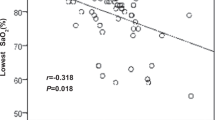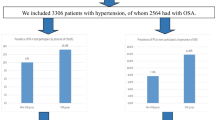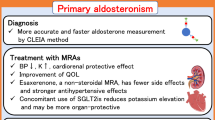Abstract
Obstructive sleep apnoea (OSA) is known to commonly co-exist with primary aldosteronism (PA), but it is unknown if treatment of PA improves sleep apnoea parameters in these patients. We therefore aimed to determine whether specific medical or surgical treatment of PA improves OSA, as measured by the apnoea–hypopnoea index (AHI). We recruited patients undergoing diagnostic workup for PA if they had symptoms suggestive of OSA. Patients with confirmed PA underwent polysomnography (PSG) at baseline and again at least 3 months after specific treatment for PA. Of 34 patients with PA, 7 (21%) had no evidence of OSA (AHI <5), 9 (26%) had mild (AHI ⩾5 and <15), 8 (24%) moderate (AHI ⩾15 and <30) and 10 (29%) severe OSA (AHI ⩾30). Body mass index tertile, neck circumference and 24 h urinary sodium correlated with the AHI. Twenty patients had repeat PSG performed after treatment for PA (mineralocorticoid receptor antagonists in 13 with bilateral PA and adrenalectomy in 7 with unilateral PA). In this group the median (s.d.) AHI reduced from 22.5 (14.7) to 12.3 (12.1) (P=0.02). Neck circumference reduced with PA treatment (41.6 vs 41.2 cm, P=0.012). OSA is common in patients with primary aldosteronism and may improve with specific therapy for this disease. Aldosterone and sodium-mediated fluid retention in the upper airways and neck region may be a potential mechanism for this relationship.
This is a preview of subscription content, access via your institution
Access options
Subscribe to this journal
Receive 12 digital issues and online access to articles
$119.00 per year
only $9.92 per issue
Buy this article
- Purchase on Springer Link
- Instant access to full article PDF
Prices may be subject to local taxes which are calculated during checkout


Similar content being viewed by others
References
Hedner J, Bengtsson-Bostrom K, Peker Y, Grote L, Rastam L, Lindblad U . Hypertension prevalence in obstructive sleep apnoea and sex: a population-based case-control study. Eur Respir J 2006; 27 (3): 564–570.
Drager LF, Genta PR, Pedrosa RP, Nerbass FB, Gonzaga CC, Krieger EM et al. Characteristics and predictors of obstructive sleep apnea in patients with systemic hypertension. Am J Cardiol 2010; 105 (8): 1135–1139.
Marin JM, Agusti A, Villar I, Forner M, Nieto D, Carrizo SJ et al. Association between treated and untreated obstructive sleep apnea and risk of hypertension. JAMA 2012; 307 (20): 2169–2176.
Peppard PE, Young T, Palta M, Skatrud J . Prospective study of the association between sleep-disordered breathing and hypertension. N Engl J Med 2000; 342 (19): 1378–1384.
Calhoun DA, Jones D, Textor S, Goff DC, Murphy TP, Toto RD et al. Resistant hypertension: diagnosis, evaluation, and treatment. A scientific statement from the American Heart Association Professional Education Committee of the Council for High Blood Pressure Research. Hypertension 2008; 51 (6): 1403–1419.
Goncalves SC, Martinez D, Gus M, de Abreu-Silva EO, Bertoluci C, Dutra I et al. Obstructive sleep apnea and resistant hypertension: a case-control study. Chest 2007; 132 (6): 1858–1862.
Lavie P, Hoffstein V . Sleep apnea syndrome: a possible contributing factor to resistant. Sleep 2001; 24 (6): 721–725.
Pratt-Ubunama MN, Nishizaka MK, Boedefeld RL, Cofield SS, Harding SM, Calhoun DA . Plasma aldosterone is related to severity of obstructive sleep apnea in subjects with resistant hypertension. Chest 2007; 131 (2): 453–459.
Calhoun DA, Nishizaka MK, Zaman MA, Harding SM . Aldosterone excretion among subjects with resistant hypertension and symptoms of sleep apnea. Chest 2004; 125 (1): 112–117.
Gonzaga CC, Gaddam KK, Ahmed MI, Pimenta E, Thomas SJ, Harding SM et al. Severity of obstructive sleep apnea is related to aldosterone status in subjects with resistant hypertension. J Clin Sleep Med 2010; 6 (4): 363–368.
Gaddam K, Pimenta E, Thomas SJ, Cofield SS, Oparil S, Harding SM et al. Spironolactone reduces severity of obstructive sleep apnoea in patients with resistant hypertension: a preliminary report. J Hum Hypertens 2010; 24 (8): 532–537.
Kasai T, Bradley TD, Friedman O, Logan AG . Effect of intensified diuretic therapy on overnight rostral fluid shift and obstructive sleep apnoea in patients with uncontrolled hypertension. J Hypertens 2014; 32 (3): 673–680.
Pimenta E, Stowasser M, Gordon RD, Harding SM, Batlouni M, Zhang B et al. Increased dietary sodium is related to severity of obstructive sleep apnea in patients with resistant hypertension and hyperaldosteronism. Chest 2013; 143 (4): 978–983.
Wolley M, Gordon RD, Pimenta E, Daunt N, Slater GJ, Ahmed AH et al. Repeating adrenal vein sampling when neither aldosterone/cortisol ratio exceeds peripheral yields a high incidence of aldosterone-producing adenoma. J Hypertens 2013; 31: 2005–2009.
Wolley MJ, Gordon RD, Ahmed AH, Stowasser M . Does contralateral suppression at adrenal venous sampling predict outcome following unilateral adrenalectomy for primary aldosteronism? A retrospective study. J Clin Endocrinol Metab 2015; 100 (4): 1477–1484.
R Core Team. R: A language and environment for statistical computing. R Foundation for Statistical Computing: Vienna, Austria, 2016. https://www.R-project.org/.
Kuznetsova A, Brockhoff PB, Christensen RHB . lmerTest: Tests in Linear Mixed Effects Models. R package version 2.0-33, 2016. https://CRAN.R-project.org/package=lmerTest.
Logan AG, Perlikowski SM, Mente A, Tisler A, Tkacova R, Niroumand M et al. High prevalence of unrecognized sleep apnoea in drug-resistant hypertension. J Hypertens 2001; 19 (12): 2271–2277.
Calhoun DA, Nishizaka MK, Zaman MA, Thakkar RB, Weissmann P . Hyperaldosteronism among black and white subjects with resistant hypertension. Hypertension 2002; 40 (6): 892–896.
Douma S, Petidis K, Doumas M, Papaefthimiou P, Triantafyllou A, Kartali N et al. Prevalence of primary hyperaldosteronism in resistant hypertension: a retrospective observational study. Lancet 2008; 371 (9628): 1921–1926.
Kopp C, Linz P, Wachsmuth L, Dahlmann A, Horbach T, Schofl C et al. (23)Na magnetic resonance imaging of tissue sodium. Hypertension 2012; 59 (1): 167–172.
Wu CH, Yang YW, Hung SC, Tsai YC, Hu YH, Lin YH et al. Effect of treatment on body fluid in patients with unilateral aldosterone producing adenoma: adrenalectomy versus spironolactone. Sci Rep 2015; 5: 15297.
Chiu KL, Ryan CM, Shiota S, Ruttanaumpawan P, Arzt M, Haight JS et al. Fluid shift by lower body positive pressure increases pharyngeal resistance in healthy subjects. Am J Respir Crit Care Med 2006; 174 (12): 1378–1383.
Redolfi S, Yumino D, Ruttanaumpawan P, Yau B, Su MC, Lam J et al. Relationship between overnight rostral fluid shift and obstructive sleep apnea in nonobese men. Am J Respir Crit Care Med 2009; 179 (3): 241–246.
Nicholl DD, Ahmed SB, Loewen AH, Hemmelgarn BR, Sola DY, Beecroft JM et al. Declining kidney function increases the prevalence of sleep apnea and nocturnal hypoxia. Chest 2012; 141 (6): 1422–1430.
Yumino D, Wang H, Floras JS, Newton GE, Mak S, Ruttanaumpawan P et al. Prevalence and physiological predictors of sleep apnea in patients with heart failure and systolic dysfunction. J Card Fail 2009; 15 (4): 279–285.
Elias RM, Bradley TD, Kasai T, Motwani SS, Chan CT . Rostral overnight fluid shift in end-stage renal disease: relationship with obstructive sleep apnea. Nephrol Dial Transplant 2012; 27 (4): 1569–1573.
Yumino D, Redolfi S, Ruttanaumpawan P, Su MC, Smith S, Newton GE et al. Nocturnal rostral fluid shift: a unifying concept for the pathogenesis of obstructive and central sleep apnea in men with heart failure. Circulation 2010; 121 (14): 1598–1605.
Yucel A, Unlu M, Haktanir A, Acar M, Fidan F . Evaluation of the upper airway cross-sectional area changes in different degrees of severity of obstructive sleep apnea syndrome: cephalometric and dynamic CT study. AJNR Am J Neuroradiol 2005; 26 (10): 2624–2629.
Avrahami E, Englender M . Relation between CT axial cross-sectional area of the oropharynx and obstructive sleep apnea syndrome in adults. AJNR Am J Neuroradiol 1995; 16 (1): 135–140.
Brown LK . Mild obstructive sleep apnea syndrome should be treated. J Clin Sleep Med 2007; 3 (3): 259–262.
Littner MR . Mild obstructive sleep apnea syndrome should not be treated. J Clin Sleep Med 2007; 3 (3): 263–264.
Barbe F, Duran-Cantolla J, Sanchez-de-la-Torre M, Martinez-Alonso M, Carmona C, Barcelo A et al. Effect of continuous positive airway pressure on the incidence of hypertension and cardiovascular events in nonsleepy patients with obstructive sleep apnea: a randomized controlled trial. JAMA 2012; 307 (20): 2161–2168.
McEvoy RD, Antic NA, Heeley E, Luo Y, Ou Q, Zhang X et al. CPAP for prevention of cardiovascular events in obstructive sleep apnea. N Engl J Med. 2016; 375 (10): 919–931.
Catena C, Colussi G, Lapenna R, Nadalini E, Chiuch A, Gianfagna P et al. Long-term cardiac effects of adrenalectomy or mineralocorticoid antagonists in patients with primary aldosteronism. Hypertension 2007; 50 (5): 911–918.
Catena C, Colussi G, Nadalini E, Chiuch A, Baroselli S, Lapenna R et al. Cardiovascular outcomes in patients with primary aldosteronism after treatment. Arch Intern Med. 2008; 168 (1): 80–85.
Author information
Authors and Affiliations
Corresponding author
Ethics declarations
Competing interests
EP is an employee of Bayer Pharma; however, this article reflects the views of the author and should not be construed to represent Bayer Pharma views or policies of its affiliates or its employees. The remaining authors declare no conflict of interest.
Rights and permissions
About this article
Cite this article
Wolley, M., Pimenta, E., Calhoun, D. et al. Treatment of primary aldosteronism is associated with a reduction in the severity of obstructive sleep apnoea. J Hum Hypertens 31, 561–567 (2017). https://doi.org/10.1038/jhh.2017.28
Received:
Revised:
Accepted:
Published:
Issue Date:
DOI: https://doi.org/10.1038/jhh.2017.28
This article is cited by
-
Endocrine causes of hypertension: literature review and practical approach
Hypertension Research (2023)
-
Associations between primary aldosteronism and diabetes, poor bone health, and sleep apnea—what do we know so far?
Journal of Human Hypertension (2020)
-
Management of primary aldosteronism and mineralocorticoid receptor-associated hypertension
Hypertension Research (2020)
-
A pilot study in men to show the effects of postural fluid shifts on the severity of obstructive sleep apnea
Sleep and Breathing (2020)
-
Clinical characteristics of snoring patients with primary aldosteronism and obstructive sleep apnea–hypopnea syndrome
Journal of Human Hypertension (2019)



